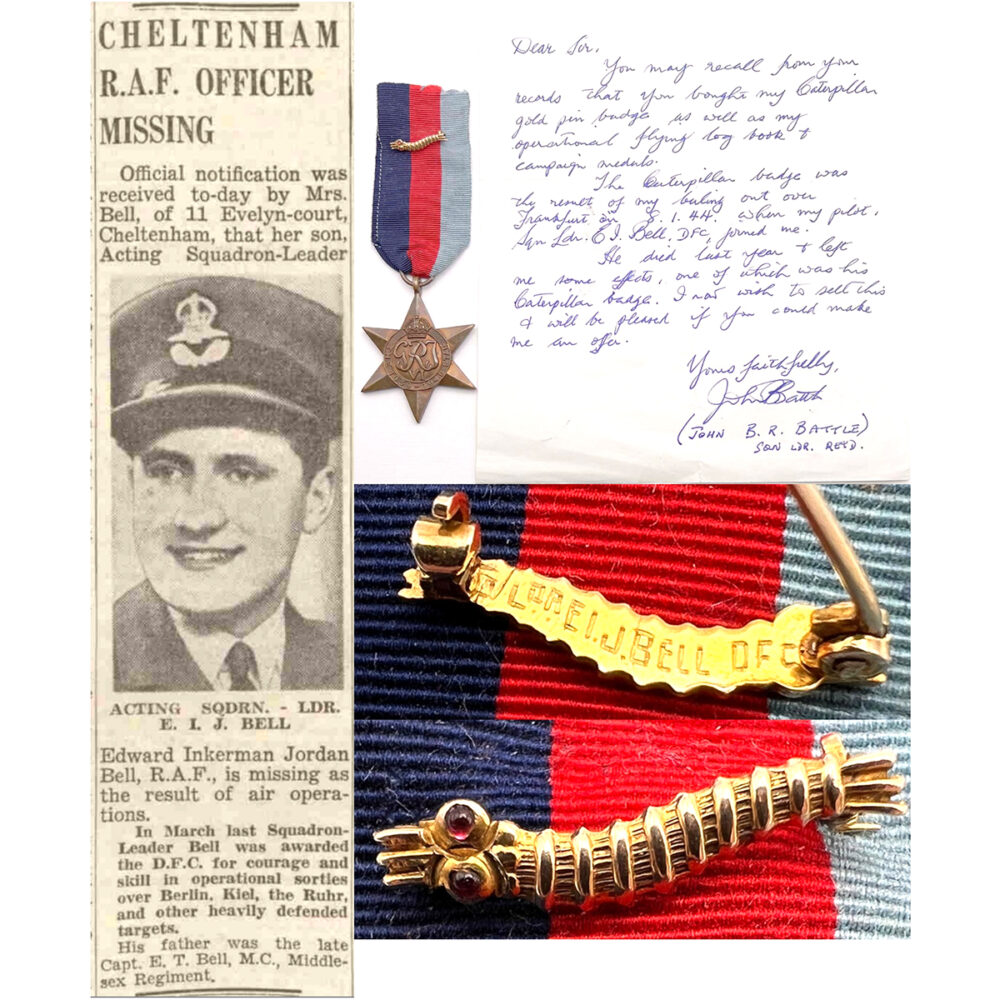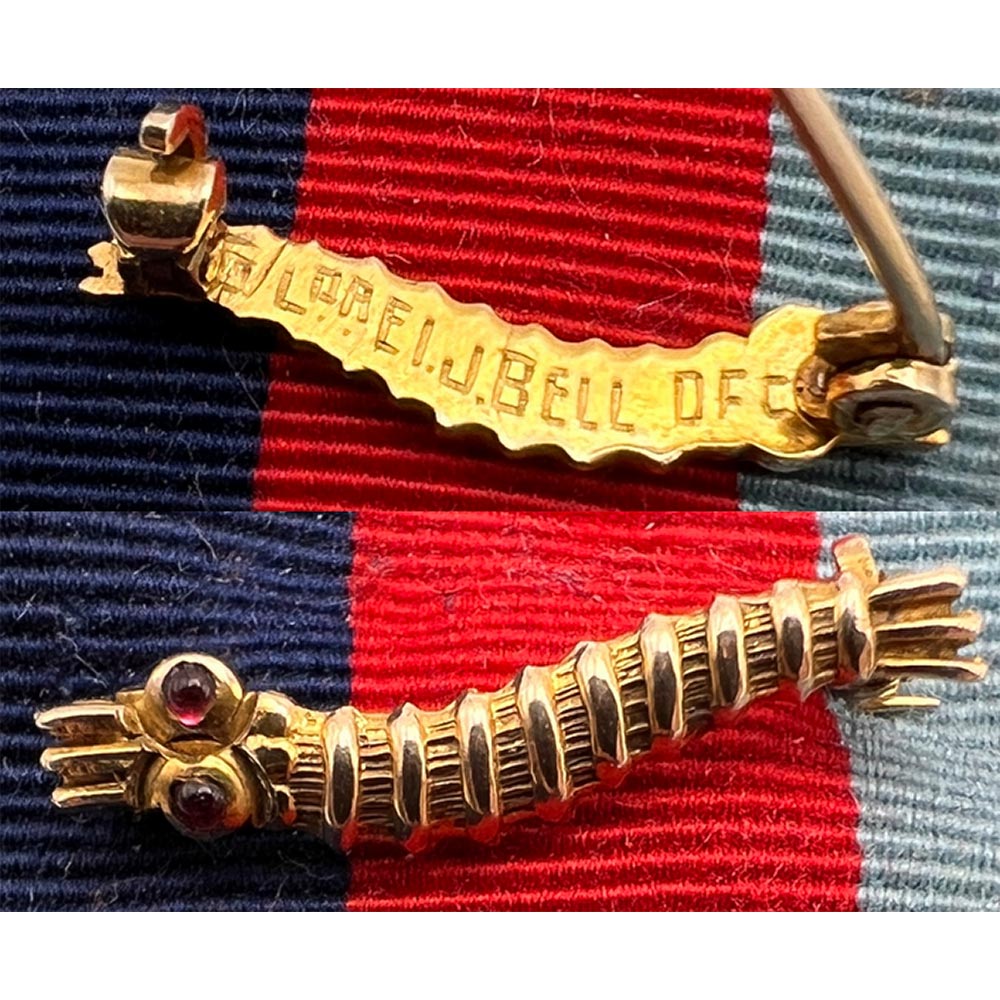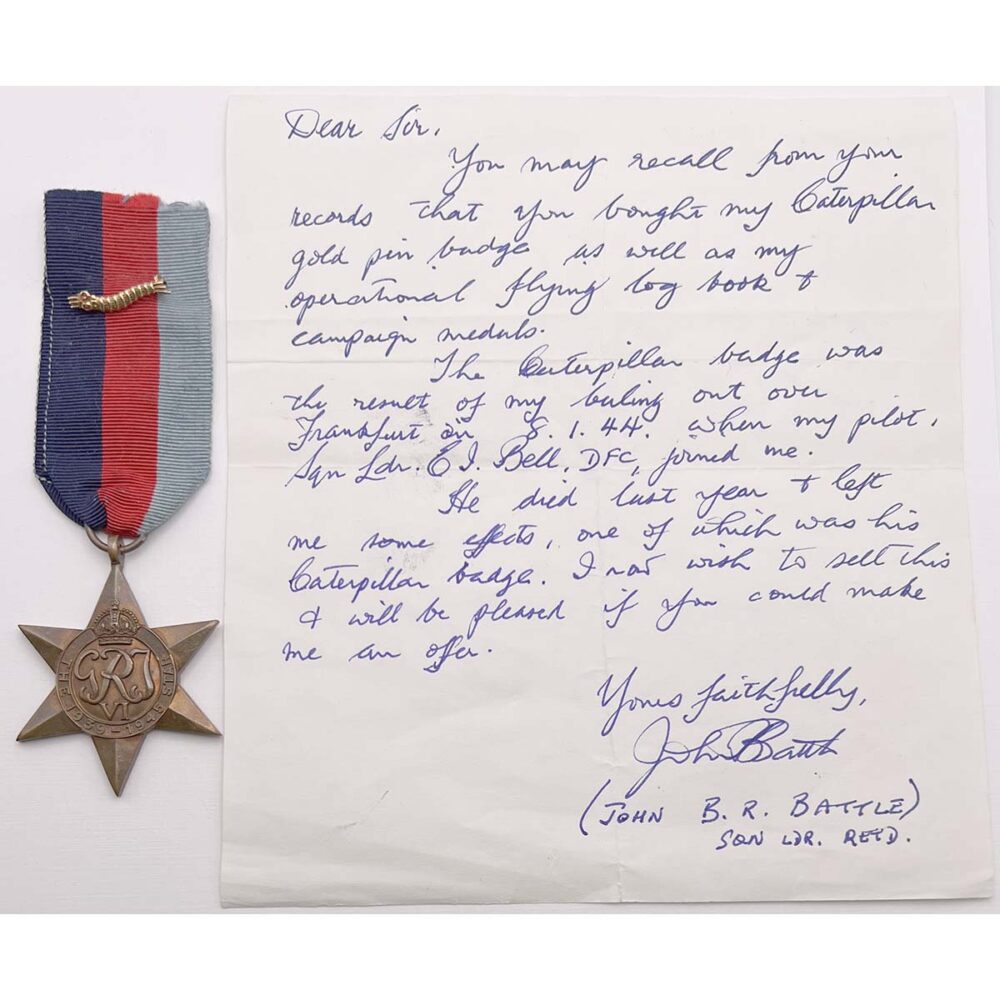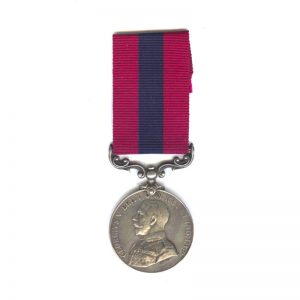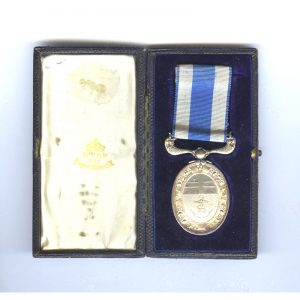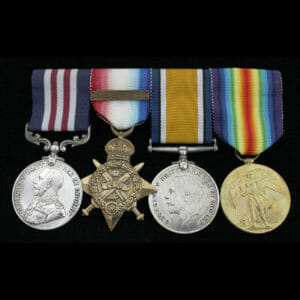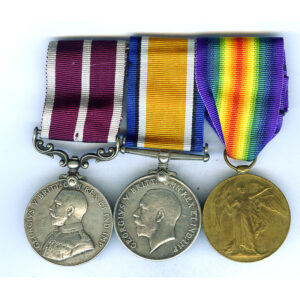Description
Caterpillar Club Badge, Gold, Squadron Leader and Major Edward Inkermann Jordan “Dinger” Bell, DFC, 12 Sqn RAF, went down over Germany and Taken POW at Stalag Luft III of Great Escape fame.
Major and Squadron Leader Edward Inkermann Jordan Bell DFC or “Dinger” as he was known.
Came from the Army to the RAF in 1940, trained as a Pilot, went down over Spain, leading to an amusing few months in the hands of the very angry but thankfully neutral Spanish.
Released to become a Bomber Pilot, earning a DFC with 12 Squadron and rising to Flight Commander.
Transferred to 627 Pathfinder “Mossie” Squadron and went down over Frankfurt being shot down by flak in his De Havilland Mosquito.
The next day taken as a Prisoner of War with his Observer and soon after booked into Stalag Luft III, being there 2 months before the Great Escape.
After the Red Army freed him by the end of the war, he rejoined the Army and qualified as a Glider Pilot.
He reached the rank of Major with his old regiment, the North Staffordshire Regiment and served in the Korean War with them.
A solid gold badge with “Ruby” eyes, Caterpillar Club badge pinned to the silk ribbon of an original 1939-45 Star.
Engraved as issued on reverse: “S/Ldr E.I.J. BELL DFC”
Provenance of this badge:
When Bell’s de Havilland DH98 Mosquito went down over Frankfurt on 8th January 1944, he was flying with his Navigator F/O John Rees Bernard Battle.
The two of them were forced to bale out of the plane when they were flying to Frankfurt, both of them survived.
However upon landing in Germany, they were arrested, being processed and admitted to the soon to be famous Stalag Luft III at Sagan, Bell taking prisoner number 3294 and his Nav Battle number 3292.
After the war, both men received the Gold Caterpillar Club Badge, Bell already being a DFC winner had this noted on the engraving.
Many years later, around 1994, following the death of Sqn Ldr Bell in May 1993, who had left in his will, the Gold Caterpillar Club badge to his wartime comrade with whom it was earned alongside.
When Sqn Ldr Battle later sold his own Badge and Log Books circa 1994, he chose to also part with this exact badge.
These details are recounted in a hand written letter of provenance signed by Mr Battle, included with the badge.
It is assumed that their survival was attributed to the Irving Parachutes they were fitted with, as the strict requirements of joining the famous “Caterpillar Club” is that the Irving Company would conduct an investigation to ensure that their Parachute had indeed been deployed and was what prevented their death.
Both men were issued with the Caterpillar Club Badge.
FATHER AND EARLY LIFE
Squadron Leader Edward Inkermann Bell D.F.C. was one of many of his family to carry the “Inkermann” middle name.
His father, who he was named in memory of, was the popular and incredibly brave Professional Footballer Edward Inkermann Jordan Bell, awarded the Military Cross with Second Award Clasp, known as “Edward” Bell.
He had made a name for himself in the 17th Middlesex Regt known as the “Footballers Battalion”, where he rose to Command, earning a Military Cross for repelling a counter attack at Delville Wood, and was finally killed in action during the German Spring Offensive, a few months later it was confirmed that he would receive a posthumous second award of the Military Cross.
6 Months after his father was killed in action, his widow Edith Anne Bell, had a Son, naming him after his father, so the Major E.I.J. Bell DFC was born.
ENTRANCE INTO THE ARMY AND RAF
Originally an Army Officer, Bell first received a commissioned like his Father and Grandfather before him, being commissioned into the Army coming from Sandhurst Military College during 1938.
He first transferred to the Royal Air Force on 11th April 1940, on attachment from the North Staffordshire Regiment.
CRASH LANDED IN SPAIN AND INTERNED
By 1941 he was flying, when he was forced to ditch his plane in the sea off the coast of Spain, being interned for some time until he was returned the next year. He was flying Wellington Z8722 of OADU, on 20th June 1941 whilst doing a delivery flight from Hampstead Norris to the Middle East, flying via Gibraltar.
They were forced to ditch the plane in the sea near Aguilas, he and his crew were then interned until March 1942.
The event was very amusing to the locals of Aguilas, as the 6 British Airmen spoke no Spanish and vice versa, however the local authorities were quite angry that yet another British Plane had crashed into Neutral Spain, so the crew were interred for a while, as the Pilot Bell was frequently interrogated, where he comically adds that:
"We were flying thirteen hours around the coast, without finding the damn rock."
The full story of the crash is told in a detailed article by the Spanish Historian Miguel Puchol Franco, titled “A Wellington in Águilas”
RELEASED FROM SPAIN AND AWARDED THE DFC FOR A TOUR WITH BOMBER COMMAND RISING TO OFFICER COMMANDING B FLIGHT 12 SQUADRON
After being freed he began his active service as a Bomber Pilot with 12 Squadron, where he rose from Flt Lt to Officer Commanding of “B” Flight, as an Acting Squadron Leader, there is a very detailed full report of his recommendation included for his Distinguished Flying Cross, for his gallant tour of duty.
Edward earned his Distinguished Flying Cross, with 12 Squadron whilst on a tour with Bomber Command.
He had completed 25 Sorties over 133 Flying Hours as a Flight Lieutenant, Acting Squadron Leader, who was also even with his Rank the Officer Commanding of “B” Flight”.
The recommendation from his Wing Commander dated 21st January 1943:
“Squadron Leader Bell has carried out 25 sorties against the enemy. These operations include sorties to Berlin, Kiel, and 7 to the Ruhr Valley where heavy flak and fighter opposition were encountered.
He has carried out these attacks with consistent courage and skill. Throughout he has set a fine example to his Flight and the Squadron by his cheerfulness, cool judgement and determination to press home his attacks frequently in the face of strong enemy opposition.
His leadership has contributed in no small measure to the success of this Squadron, maintaining morale at a very high level, and is worthy of the highest praise.
he is an ideal leader of men who has consistently shown great devotion to duty, and full merits the award of the Distinguished Flying Cross.”
The remarks by his Station Commander:
“Squadron Leader Bell is a most irrepressible officer, seething with energy and an insatiable appetite for operational flying.
As a Flight Commander he sets a magnificent example of enthusiasm and determination, and as a captain he is outstanding. He has coolness, judgement, initiative and common sense of a high order and all his operations are carried out precisely in accordance with a carefully thought out plan.
S/Ldr Bell is undeterred by the heaviest defences or the foulest of weather. I have no hesitation in recommending him for the award of the D.F.C.”
NEW POSTING AS A DE HAVILLAND MOSQUITO FIGHTER PILOT SHOT DOWN OVER GERMANY AND TAKEN PRISONER
After being awarded the D.F.C. he went on to another posting, now becoming a Mosquito Fighter Pilot with his old pal Flying Officer John Rees Bernard Battle.
They were in a Mosquito DH98, DK293 flying with 627 Squadron when they went down over Frankfurt on 8th January 1944.
They were captured soon after and both of them were taken together as Prisoners of War.
“Captured Near Frankfurt 10th January 1944.”
CAMPS
Dulag Luft, in Frankfurti, 13th January 1944 to 27th January 1944
STALAG LUFT III, Belaria, Sagan, 29th January 1944 to 28th January 1945
Stalag Luft IIIA, Luckenwalde, 4th February 1945 – 20th May 1945.
During his time as a Prisoner of War, he was taken to the soon to be famous Stalag Luft III in Sagan now Zagan, Poland.
He was booked into Stalag Luft III on 29th January 1944.
After a year of planning Squadron Leader Roger Bushell led what would be called “The Great Escape” on the night of 24-25th March 1944.
Of course out of the 76 successful escapers, 73 of them were captured, a large number of them were murdered by the Gestapo and only a small few returned back to the camp.
His transfer over to Stalag Luft IIIA and eventual freedom.
In early 1945, about 1,000 POWs from Stalag VIIC and Stalag Luft III (including Bell) were brought over to Stalag III-A, and also POWs from the Stalag XXI-C in Wolzstyn. Also in February 1945 more prisoners from Stalag III-B in Furstenberg, were evacuated to Stalag III-A, which added to the already overcrowded and unhygienic conditions.
Finally the Russians made their approach and all the guards bolted, leaving behind the prisoner to be liberated courtesy of the Red Army on 22nd April 1945.
AFTER WW2 GLIDER PILOT AND KOREAN WAR
Following the end of the war, he returned back to the Army and trained as a Glider Pilot qualifying in 1948.
He would go on to see further war service in the Korean War whilst a Major and Company Commander with his old regiment, 1st Battalion Staffordshire Regiment.
He retied from the Army in 1961.
Later died aged 74 on 28th May 1993.
